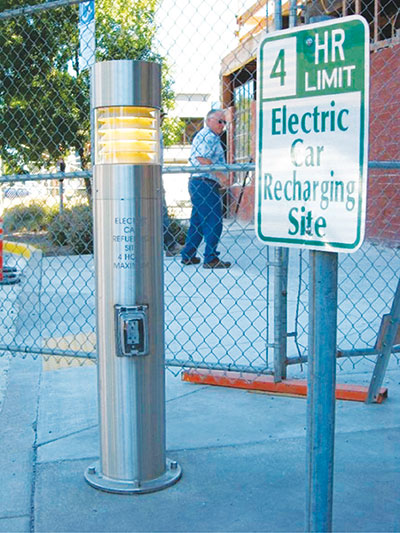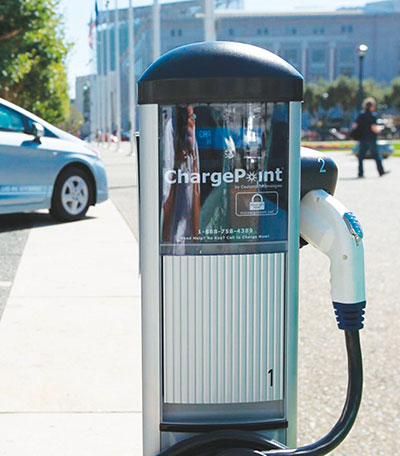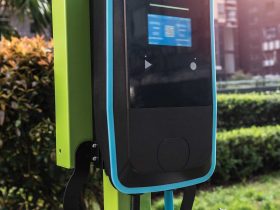The advanced investment of this pathway infrastructure will continue to play a vital role in the adoption of EVs into our transportation system. However, continued integration of electric vehicles by consumers is dependent on the availability and ease of use of charging facilities.
Although the location and status of each unit may be identified through websites as well as applications on mobile devices, significant inconsistencies remain in the physical appearance, location, and access to this equipment. Electrical codes dictate the standards for materials, installation procedures, and connection to the electrical grid, but the user interface including physical access, signage, use limitations, area demarcations and cost are largely unregulated or standardized and are subject to the discretion of the facility owner. However, a few states have already devised guidelines to combat this problem. A wide range of regulations and policies in the states of California, Washington, Hawaii, Minnesota, Virginia, and Oregon stipulate everything from vehicle charging rates to the exact placement of EV charging systems, parking space dimensions, and signage.

Photo 1. Convenience is important.
For over a year I have been utilizing a wide variety of charging station facilities and have experienced a number of impediments which hinder the convenience of recharging my Chevy Volt. Many hotels, restaurants, supermarkets, and parking facilities have installed EV equipment, an amenity which is rapidly becoming a business imperative in the corporate world. Nonetheless, charging stations have not yet reached widespread prevalence in the most convenient locations. Areas where people are engaged in commerce for a period of hours, such as malls, golf courses, theaters, or transportation facilities, represent significant new opportunities for EV charger installation.

Photo 2. Signage is extremely important.
The vast majority of the charging units that I’ve used were identified through a mobile device prior to departing for unfamiliar destinations. Mobile applications such as PlugShare provide the locations of both private charge stations (which require advanced permission) and publicly available options. Vender specific mobile apps alert you to the location and availability of charging stations equipped solely by their company. Mobile apps usually provide the specific address of the host facility, conditions for use, user comments, level of charge capacity (120v or 240v), directions, and photographs to aid with navigation to the charging facility.

Photo 3. Accessibility is important.
Based on my use and observations of dozens of charging stations, I have compiled a list of Best Practices for facility owners and real estate managers to consider.
Signage is extremely important to locate and then operate the charging equipment. It should be large and well lit at night to avoid the need to search for EV charging stations, especially when entering a parking lot or garage. The vast majority of facilities that offer this amenity have limited instructional signage to direct vehicle operators to designated spaces.
Optimum content for signage:
•reservation of parking spot for electric vehicles only
•name and phone number of
organization responsible for operation and upkeep
•time limitations
•level of amperage
•user fee or rates
•consequences of violation of either time limit or type of vehicle:
“Violators will be towed at owners expense” towing company and telephone number days and hours of operation
An effective method of identifying a charging facility and its designated equipment is the demarcation of individual spaces using easily identifiable EV symbols with bright green paint either on the entire parking space or within one of several plug-in EV logos. Similar to the blue demarcations of handicap parking spaces, green designation of EV parking spaces assists with identification by EV operators and serves as a deterrent or vibrant reminder to conventional vehicle operators. The Seaport Hotel in Boston provides a fantastic example of a clean, well lit, properly designated charging facility.
Convenience will also play a significant roleas the purchase of EVs becomes more widely accepted. Unobstructed access to EV charging stations may seem logical, but I have found that a number of parking facilities have limited or prohibited access. Some restrict access by means of “residents only” or “Do Not Enter” signage, as seen at the Handover Parking Garage in Portsmouth, NH. I had a particularly difficult time tracking down one charging station noted on a mobile app when, after an extensive investigation effort, I was informed that the charging station was located in an underground parking garage referred to as Harbour Front Centre in Toronto, Canada. No trace of evidence on the ground would lead one to conclude that this charging facility even existed. A construction fence prohibited access and only through the kind-hearted assistance of facility staff did it become known that the garage was not even scheduled to open for another two weeks!

Photo 3. Lenox Hotel is the first privately owned, privately funded, company in the city of Boston to install a visible-to-the-public, electric vehicle curb-side charging station. Hotel and restaurant guests can receive complimentary valet parking along with free charging for their electric vehicle.
Accessibility measures may allow disabled persons a greater chance to operate an electric vehicle in a safer and more convenient environment. The first of every 25 EV charging spots, or any available and convenient space should be reserved exclusively for the use of disabled persons. This requires a parking space at a diagonal or perpendicular to the curb with ample space around the charging equipment as well as a barrier-free route of travel. Close proximity to the entrance of the building will allow equal opportunities to all electric vehicle drivers. Accessibility should also include sidewalk clearance for pedestrian passage if in a public area.
Charging station maintenance and protection should be put in place. Charging equipment may either have a retractable cord or a clear place to hang the cord at an appropriate height above the ground. Curbs, wheel stops, or steel bollards prove useful in protecting EV charging stations, especially those placed near an angled or perpendicular parking spot.
EV charging spots must clearly mark their policies and procedures in regards to payment or fees. If requiring a card reader, this device should be clear of obstruction, visible, and at easy level for reach. Free EV charging spots may promote energy efficiency or entice new customers or clients to the business providing the service. These free spots should be well promoted and clear for the driver to understand.
Public education is highly recommended to inform occupants, tenants and visitors of the availability and location of charging stations. This information should be available through websites for individual companies and facility owners. The public is far more likely to consider EVs if awareness of EV infrastructure and equipment is increased. In my opinion, the public charging stations available at City Hall in Boston have increased public awareness more than any other charging stations in New England due to their high profile location and near-constant use.
Use enforcement of EV parking spaces is necessaryto prevent conventional gas powered vehicle operators from occupying EV charging stations. Enforcement may pose challenges, given that the spaces are often in preferred areas, and are desirable due to proximity to elevators and stairwells, building access and pedestrian walkways.
As electric vehicle popularity soars, charging station availability through policing of time limitations will be critical to continued expansion. In addition to education of policies through proper signage, communication of charge completion is one method of insuring that idle equipment does not go to waste. The On-Star app for my Chevy Volt emails me upon complete charge or any premature disruption.
Illumination of parking space(s) is extremely helpful for the payment and use of charging stations. Despite vehicle safety considerations such as the illumination of the J1772 EV plug connection, dimly lit surroundings can make it difficult to identify charging equipment and designated spaces.
As our transportation system evolves, these recommendations will maximize the potential use and benefit of EV charging stations. The adoption of such amenities serves as a strategic differentiator between forward thinking businesses and those who choose to fall behind in a competitive environment. Minimizing the time and effort necessary to utilize charging stations will improve integration of EVs into our transportation system, reducing both our reliance on foreign oil and our carbon emissions. Widespread and well-executed EV infrastructure will provide the groundwork for a stronger economy and healthier environment for our country now and for future generations.














Find Us on Socials